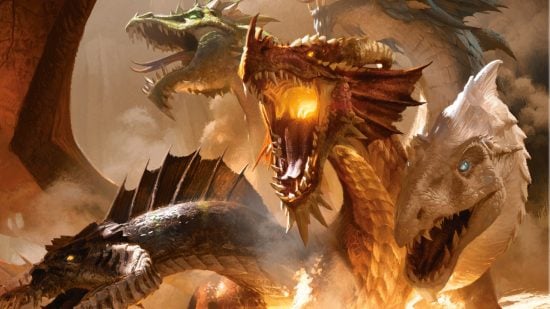There are thirteen different DnD damage types, thirteen categories to describe the many different ways you can slash, freeze, burn, zap, shatter, or otherwise dispatch your fiendish foes. Here we’ll cover each of them, as well as discussing their role within Dungeons and Dragons.
If you’re wondering what DnD spells use each damage type, or the DnD class you should play to gain easy access to a particular kind of damage, this is the guide for you. We’ll also teach you about damage from the DM’s side of the table: which DnD monsters make use of each damage type and how to avoid a beast’s resistances, while making the most of its vulnerabilities.
If you’re just after an extremely quick overview of the main DnD damage types, check out the table below:
| DnD Damage Type | Example | Strong against | Weak against |
| Piercing | Spears, bites | Rakshasa (if magical) | Swarms, ghosts, treants |
| Bludgeoning | Maces, unarmed strikes | Skeletons, ice mephits | Swarms, ghosts, treants |
| Slashing | Swords, talons | None | Swarms, ghosts, oozes |
| Cold | Cone of cold, ice devil’s spear | Salamanders | Liches, storm giants, fiends |
| Fire | Burning hands, salamander’s tail | Ice mephits, scarecrows, treants, wood woads | Salamanders, fiends, some oozes |
| Lightning | Storm giant’s lightning bolt | None | Air elementals, liches, some fiends |
| Thunder | Shatter, thunderwave | Zaratan, earth elementals | Air elementals, some undead |
| Poison | Stings and bites | None | Assassins, duergar, loads of fiends, elementals, and undead |
| Acid | Acid arrow, black dragon’s breath weapon | None | Black dragons, golems, mimics |
| Necrotic | Wight’s life drain attack | None | Most undead |
| Radiant | Angel’s weapon attack | Shadows, shadow demons | Skulks, celestial monsters |
| Force | Magic missile | None | Helmed horrors (and that’s it!) |
| Psychic | Psionic blast, mindflayer’s powers | Flumphs | Constructs and aberrations |
Piercing
You duck the giant’s club, then loose a crossbow bolt into its ankle.
The first three DnD damage types are what you might call the Physical damage types. They’re some of the most common forms of damage in the game, dished out by all common DnD weapons. That means every class that regularly uses a weapon, from the Fighter 5e to the Rogue 5e, will make use of these damage types.
Piercing specifically refers to stabbing, puncturing wounds, of the kind dealt by spears, bows, and rapiers. Like the other physical damage types, there are almost no creatures that are vulnerable to piercing damage, but also few that actively resist it. You’ll mainly have trouble fighting swarms of little biting things, or ethereal creatures like ghosts.
Interestingly, the tiger demon Rakshaha are vulnerable to piercing damage, but only when its dealt by a magical weapon, and only if that weapon is wielded by a hero of a good DnD alignment.
Piercing damage is also commonly dished out by monsters, from spear wielding humanoids to beasts attacking with bites, horns, spikes, or thorns.
Bludgeoning
You deliver the unruly drunk a staggering knock-out blow, then whack him with a stool for good measure.
Bludgeoning damage refers to blunt force trauma, of the kind delivered by maces and warhammers, or a fist. It’s the default for unarmed combat, so a DnD Monk will make immense use of this damage type, but again this is one type that no player will have trouble accessing.
Bludgeoning is arguably the strongest of the physical damage types. Similar monsters resist it, but unlike slashing or piercing, a few common monsters are vulnerable to getting bludgeoned, most notably skeletons.
Slashing
You scream out as the owl bear’s claw catches your side, raking across your flesh.
Slashing damage is the third physical damage type, and it refers to cutting attacks of the kind delivered by a sword or an axe, or by a monster’s claws.
While few creatures have vulnerabilities, there are many that have resistances to multiple damage types, and then one damage type missing. So for instance, treants are not vulnerable to slashing damage, but they are resistant to bludgeoning and piercing. In a sense, they have a sort of pseudo-vulnerability to slashing by way of being resistant to other weapons. It certainly makes sense that a tree person would find an axe more concerning than a rapier.
One type of monster you want to watch out for if you’re dealing slashing damage is oozes. There are a few different types of jelly and slime that split in half when they’re dealt sufficient slashing damage.
Cold
A blast of freezing air jets forth from your fingertips, encasing the goblin in ice.
We’ve now departed from the most common DnD damage types and are now looking at damage that’s most often dealt by magic.
Cold damage is a little less intuitive to imagine than fire, but it’s still pretty straightforward. It refers to the pain and damage caused by sudden exposure to immensely cold temperatures. You’ll probably need a spellcasting class or a 5e magic item to make use of it.
In terms of spells, the DnD Wizard gets Cone of Cold, delivering a huge amount of AoE cold damage. Meanwhile, the 5e Warlock gets a fantastic defensive cold spell in Armor of Agathys, gaining temporary hit points and dealing cold damage to those who come too near. Monstrous sources of the damage type include elementals, yetis, and frosty white dragonbreath.
There are a few monsters that are weak to cold damage, most of which are some kind of fire monster like the Salamander. But on the flipside, a large number of monsters say the cold never bothered them (anyway). If a creature looks wintry and ice-clad it might be totally immune, while most fiends are resistant to cold damage.
Fire
Ushering patrons out of the burning inn, your arms are singed by a sudden conflagration.
Fire damage is self-explanatory: we all know what fire is and how it damages stuff. In terms of dishing it out, there are plenty of spells to draw from, and if you want to be throwing Fireballs nonstop, we suggest the Evocation DnD Wizard subclass could be right for you.
However, unlike cold or lightning, you can also harness fire using mundane equipment. If you’re out of spell slots, oil flasks and a tinderbox may come in clutch to turn up the heat on a burnable monster.
Fire damage is a rather mixed bag. It has a higher number of vulnerable monsters than any other damage type (wooden or ice-based enemies beware) but more monsters resist fire than any other damage type, barring poison. In particular, if you’re taking a trip to the nine hells, leave your fire scrolls at home. Fiends will have a field day with fire reliant PCs.
Lightning
The foolish bugbear jabs the artificer’s machine with his knife, leading to a flash and the smell of singed hair.
Lightning damage refers to harm caused by high voltage electricity, which you’re unlikely to come across through normal means unless you stand on a tower in full plate mail during a storm (or your DnD setting has discovered electricity). So it’s to the DnD spells list we turn once again, where the lightning spells range from small cantrips like Shocking Grasp to big hitters like Chain Lightning.
In terms of high electricity monsters you’re likely to meet, the blue DnD dragon unleashes lightning on its foes, while storm giants can hurl lightning bolts from range. There aren’t any monsters particularly vulnerable to lightning damage, but it’s not a very resisted damage type either. Most monsters that resist lightning also resist other common types like fire and cold damage.
Thunder
The shatter spell releases an eardrum-rupturing sound, cracking the crystal wall.
Not to be confused with the previous entry, thunder refers to damage caused by an intense shockwave of sound. In fact, it was known as ‘sonic damage’ in 4th edition. It’s one of the stronger damage types in DnD, having only a few resistant or immune monsters, and being strong against earth elementals.
It’s also quite rare that you’ll come up against it. If you want to avoid thunder damage, be careful not to piss off any Djinn.
Poison
As your stomach lurches, you glance at your goblet in horror.
Poison damage comes from contact with or ingestion of harmful substances. There aren’t that many spells that inflict it, and in fact this is a damage type that seems more likely to come from a monster, whether a serpent, green dragon, or countless other stinging or fanged monsters.
Unfortunately for those who do take the trouble to pick up a poison spell, poison is one of the least effective damage types, resisted by an enormous portion of the monster manual. Anything with a strong constitution or no blood is likely to shrug off poison attacks. That’s undead, demons, constructs, elementals: all sorts!
Acid
I’m mellltinng, shrieks the lich, sinking slowly into the deadly pool.
Now we’re getting to the good stuff. Unlike poison, which generally has to be ingested or injected to cause harm, acid damage comes from corrosive, dissolving substances that are harmful to the touch.
It’s a good DnD damage type because it’s highly consistent. Though there are no monsters with acid vulnerability, very few monsters are immune to acid’s (I was going to say charms, but that’s not it) power. Acid does struggle against some inanimate creatures like the 5e mimic, but overall spells like Melf’s Acid Arrow are reliable favorites. Along with fire, acid is also a damn near requisite for fighting trolls.
Radiant
A beam of holy light reduces the vampire to nothing but dust.
The next few damage types are the hardest to imagine, because they don’t correspond with anything you’ll encounter in the real world. Radiant damage, for instance, refers to the burning power of holy light. While some might expect it to be effective against all unholy, undead monsters, it’s only the darkness-dwelling shadows that actually fear the light.
While the special damage types we’ve seen so far are mainly the purview of the party’s Wizard or DnD Sorcerer, radiant damage is more likely to be wielded by a 5e Cleric or Paladin. You’re unlikely to run into much that resists it, though if you’re waging war on heaven, there are some strange celestial creatures that will only take half damage.
Necrotic
The wight’s chilling touch causes your skin to wither.
The flipside of radiant damage, Necrotic is best described as ‘unholy’. Rather than devils though, it’s specifically related to the undead, who are both its main users and the monster type you don’t want to target. Interestingly, while some undead are resistant or immune to necrotic attacks, not all of them are. You’re probably better off hitting a skeleton or zombie with Chill Touch than slashing it with your sword.
While it’s often associated with evil, there’s nothing that dictates that a practitioner of necromancy or user of necrotic damage has to be bad or good.
Force
Your bolt of pure magic impacts with the hook horror at speed.
Force is a somewhat indescribable damage type that’s given to magical projectiles and weapons. Spiritual weapon and eldritch blast are common examples.
Force is often described as the best DnD damage type, and while that honorific is largely going to depend on what you’re fighting and how many dice you’re rolling, there’s no denying that it is effective. There are no creatures that are resistant to force damage, not one. And only one monster, the Helmed Horror is immune. If a monster doesn’t seem to be taking enough damage from your regular spells, it’s time to use the force.
Psychic
The mindflayer locks eyes with you and your head erupts in agony, unseeable tendrils wriggling into your brain.
One of the creepiest damage types in DnD, psychic damage refers to damaging effects that alter or harm your very mind. Inflicted by some of the spookiest monsters like the banshee or mind flayer 5e, psychic damage presumably feels like the mother of all migraines. If DnD had a sanity stat, this is the damage type that would deplete it.
Psychic is another very reliable damage type, with few monsters resisting spells like the 5e Bard’s Vicious Mockery. There are some creatures, such as mindless beings like constructs, that will be completely immune however.
That’s all the damage types there are. Now go forth and lay waste. Or read our DnD races guide. If you still haven’t found the right DnD character creator and built your PC, it might help you narrow down your choices.








